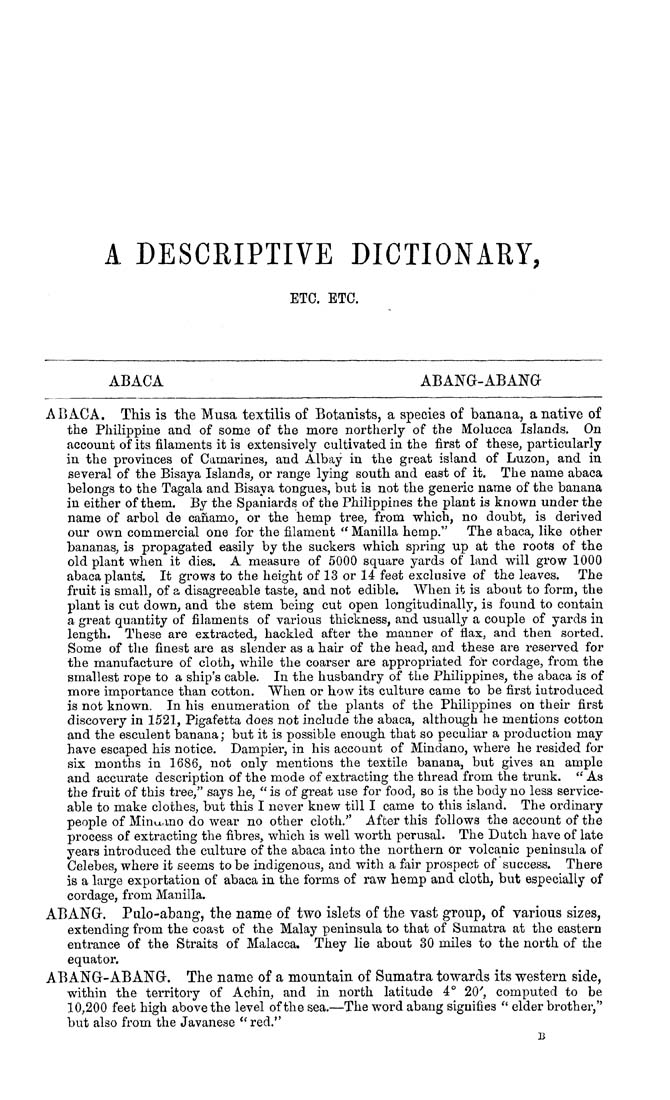A DESCRIPTIVE DICTIONARY,
ETC. ETC.
ABACA ABAlNa-ABAlSra
ABACA. This is the Musa textilis of Botanists, a species of banana, a native of
the Philippine and of some of the more northerly of the Molucca Islands. On
account of its filaments it is extensively cultivated in the first of these, particularly
in the provinces of Camarines, and Albay in the great island of Luzon, and in
several of the Bisaya Islands, or range lying south and east of it. The name abaca
belongs to the Tagala and Bisaya tongues, but is not the generic name of the banana
in either of them. By the Spaniards of the Philippines the plant is known under the
name of arbol de canamo, or the hemp tree, from which, no doubt, is derived
our own commercial one for the filament ^' Manilla hemp." The abaca, like other
bananas, is propagated easily by the suckers which spring up at the roots of the
old plant w^hen it dies. A measure of 5000 square yards of land will grow 1000
abaca plants. It grows to the height of 13 or 14 feet exclusive of the leaves. The
fruit is small, of a disagreeable taste, and not edible. When it is about to form, the
plant is cut down, and the stem being cut open longitudinally, is found to contain
a great quantity of filaments of various thickness, and usually a couple of yards in
length. These are extracted, hackled after the manner of flax, and then sorted.
Some of the finest are as slender as a hair of the head, and these are reserved for
the manufacture of cloth, while the coarser are appropriated for cordage, from the
smallest rope to a ship's cable. In the husbandry of the Philippines, the abaca is of
more importance than cotton. "When or how its culture came to be first introduced
is not known. In his enumeration of the plants of the Philippines on their first
discovery in 1521, Pigafetta does not include the abaca, although he mentions cotton
and the esculent banana; but it is possible enough that so peculiar a production may
have escaped his notice. Dampier, in his account of Mindano, where he resided for
six months in 1686, not only mentions the textile banana, but gives an ample
and accurate description of the mode of extracting the thread from the trunk. " As
the fruit of this tree," says he, " is of great use for food, so is the body no less service¬
able to make clothes, but this I never knew till I came to this island. The ordinary
people of Min*^.mo do wear no other cloth." After this follows the account of the
process of extracting the fibres, which is well worth perusal. The Dutch have of late
years introduced the culture of the abaca into the northern or volcanic peninsula of
Celebes, where it seems to be indigenous, and with a fair prospect of success. There
is a large exportation of abaca in the forms of raw hemp and cloth, but especially of
cordage, from Manilla.
ABANGr. Pulo-abang, the name of two islets of the vast group, of various sizes,
extending from the coast of the Malay peninsula to that of Sumatra at the eastern
entrance of the Straits of Malacca. They lie about 30 miles to the north of the
equator.
ABANGr-ABANG-. The name of a mountain of Sumatra towards its western side,
within the territory of Achin, and in north latitude 4° 20', computed to be
10,200 feefc high above the level of the sea.—The word abang signifies " elder brother,"
but also from the Javanese "red."
B
|








